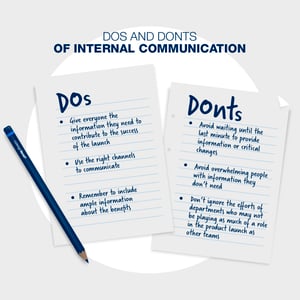A new product launch is both exciting and demanding. There is a multitude of elements involved, not to mention the investment of time and money. The surrounding marketing and planning efforts need to coincide perfectly with your message, and your ultimate objective needs to relay to your audience why this product or line of products is something the audience should care about.
A fundamental component of all of the above that is critical to the success of the product launch is communication. Specifically, internal communication for a product launch is critical — strong communication efforts with your team and your entire organization makes it easier to develop a cohesive strategy and improve overall organization and coordination. Relaying the pertinent information, and providing training, if necessary, will enable you to be better prepared to go to market, engage external stakeholders, and increase sales.The following guide offers a comprehensive checklist that will help you easily improve your internal communication for a product launch, greatly increasing your chances of success. As an added benefit, strong communication and coordination within the organization also improve productivity and morale by bringing the entire company together to focus on this exciting endeavor.
You might also like: "Everything your product launch strategy should include for a perfect launch"
5 Core elements of your internal communication
- Coordinating with your teams
- Communication timing
- Using channels for product launch communication
- Getting your teams ready
- Communicate your post-launch plans
Understanding the challenges of a product launch - developing your launch communication strategy
Before you can truly dive into your strategy development or begin writing your executive brief, you’ve got to first understand the unique challenges you face when launching a new product.
- You’ve got to be completely aware of your target market — their wants, needs, and expectations. Knowing the approximate size of your target market is also important for ensuring that your expectations match the reality of what you intend to accomplish.
- A number of teams within your organization are likely making contributions to the design, manufacturing, marketing, and launch of your product. You need to ensure consistent communication and collaboration amongst all teams and team leaders to better facilitate the process and ensure the product launch can be performed on schedule.
- Sales and marketing are meant to work in conjunction with one another. More often than not, though, they work independently, without the proper amount of interaction to be better aligned for the benefit of your company. Aligning these two teams and fostering a collaborative effort between them will ultimately lead to strong revenue growth.
With the above challenges in mind and your plans to overcome them, you are ready to begin developing your strategy for internal communication for a product launch.
1. Coordinating with your teams
While you will be providing information to the entire organization, how you approach each department or team may differ slightly. However, the main points of the overall message will likely be the same, and should include:
The objective
Letting your internal stakeholders know what you plan to achieve with the upcoming product launch sets the stage. It provides every individual within your organization with a firm idea of the ultimate goal and enables them to move forward with a strategy that helps achieve that goal.
The target audience
Who is this product intended for? How will it help them? What role does it fill? Marketing and sales aren’t the only teams that should truly understand your target audience. When the entire organization possesses an awareness of who a particular product is designed for, they can better assist in making sure the product launch is a success.
Key messages
Your internal stakeholders should understand what and how you intend to present to the audience. Your employees should also understand the message that will be delivered to the audience. After all, they are consumers too, and they can provide fresh insight and perspective on how well the message might be received.
The timeline
An extremely important part of the launch communication strategy is making sure everyone is on the same page regarding scheduled activities. This keeps everyone on track, minimizing the risk of delays and fostering communication between departments.
Details important to each specific team
Your marketing team needs to know what promotional efforts need to be performed. Your sales team must know about pricing and features. Manufacturing should be aware of production expectations. Essentially, give each department the information they require to complete their current and future tasks successfully.
In many companies, coordination within teams is challenged by having offices across countries. Different languages and cultural differences might make it difficult to present new products effectively. That’s why companies often decide to use a medium that is less susceptible to miscommunication, such as video. An explainer video could communicate key benefits and advantages of your new product better than any brief. Another option is having a product video. Look at how some of our clients utilized product videos.
2. Communication timing
Not everyone needs to know every single detail right away. Besides, despite how much initial planning is performed, a product launch is an evolving venture. Details will change, sometimes affecting the entire plan.
Therefore, as part of your launch communication strategy, it is important to develop a timeline of what and when you will communicate specific details of the product launch. This will help to cut down on confusion and create an air of anticipation within the organization about the upcoming launch.

Start with the initial planning of your product launch. This encompasses what was discussed above — understanding your target market, defining your goals, etc. This will serve as the precursor to your product narrative or executive brief. This refers to a document that contains all the pertinent information your organization will need to rally around the upcoming product launch. It will highlight the value and benefits of the product, inform your go-to-market team of its intended positioning, and your overall message to your audience.
The next step can be considered a small pre-launch. You’ll meet with sales and service teams, the marketing department, and others integral to creating content around the product.
Following that, as you grow closer to your product launch date, you’ll provide sales teams with the information and training they need to effectively sell your product. Distributors will also require advanced information to prepare for a new product or product line.
By launch day, everyone within the organization should have a complete awareness of your product narrative. This can be issued to all employees via an internal product launch email, a video, or even during in-person meetings or presentations. The initial communication can also be performed during a presentation, with email follow-ups as the launch strategy develops.
3. Using channels for product launch communication
Internal product launch emails or presentations are just some of the channels you can utilize for internal communication for a product launch. It’s important to choose your channels wisely to properly get your message and information across in the most efficient way possible.
If your company already has an internal chat or messaging tool in place, this might be the most feasible. But for providing extensive information, you can complement emails or chat messages with town-hall-style meetings.
Additionally, posting information on banners or posters throughout the area can further reinforce your message and provide additional details, as can social media updates or messages on your Intranet.
Team collaboration tools also work well in keeping communication between different teams and departments flowing smoothly and ensuring everything is moving on schedule.
In the case of bigger companies or multinational corporations, classical communication tools such as Intranet might become ineffective. But as we all know, a picture is worth a thousand words. There are several 3D technologies that could help you communicate the benefits of your product more effectively through visuals. First of all, explanatory videos showing details of your product’s functionalities might be an invaluable addition.
A bigger challenge, however, can be to communicate these benefits to your external stakeholders. How to make sure your retailers understand how to correctly assemble and sell the products?
This is how our clients such as Geberit and markilux showcase the functions and assembly manual to everybody from their internal and external stakeholders, all the way to the end-users.
4. Getting your teams ready
Post-launch you’ll need to prepare your teams for the final initialization. Product management tools are ideal for this since you’ll provide more direct and exclusive messaging rather than a single comprehensive communication. Marketing campaigns should be ready, and your sales and service teams should be standing. It’s also time to issue new, updated executive briefs to everyone, and perhaps a checklist for teams as well to ensure everything that needs to be done has, in fact, been done.
Training, if necessary, should also be performed with ample time to ensure that any teams requiring labor-intensive training have the adequate time required. Building momentum and excitement within the organization leading up to the actual product launch is also a good practice that helps everyone get motivated.
A final company meeting or presentation serves to reiterate your messaging and goals and include the organization on what is expected to be an exhilarating and positive experience.
5. DOs and DON’Ts
There’s a lot to think about and plan for when developing your product launch strategy, and there are certainly things you’ll want to do and other items you’ll want to avoid to improve your chances of success.
DOs
- Make sure you give everyone the information they need to contribute to the success of the launch. The more detailed knowledge team members have, the more they’ll be able to meet and even exceed your expectations.
- Use the right channels to communicate. Ask your teams what channels they would like to receive information through. Additionally, some times of day will work better than others. Perfect communication is a two-way street. Allow your teams to communicate their thoughts to you, and you’ll be in a better position to make sure the information gets to everyone it needs to in a proper manner.
- Remember to include ample information about the benefits of a product to each department. The benefits could be something different to each department, but overall, they need to know why they should care about their role in this product launch.
DON’Ts
- Avoid overwhelming people with information they don’t need. Tailor your communications to be specific to the different departments. For example, marketing doesn’t need details on distribution, and sales teams don’t necessarily need to know information that is intended primarily for executives.
- Avoid waiting until the last minute to provide information or critical changes to your teams. They need time to prepare and adjust, and not giving them that time can throw the entire product launch off schedule, or, worse yet, cause you to launch the product without the proper preparations, hindering its chances of success.
- Don’t ignore the efforts of departments who may not be playing as much of a role in the product launch as other teams. Everyone who contributes to the product launch should be recognized.

Post-launch plans
There’s still more to do once the product launch is over. Some teams might need to continue to provide support to others. You’ll also want to gather feedback from different teams so you can see what might be improved for future product launches. Tracking metrics, gathering feedback from customers, and showing your organization how well the product launch is performing should also be part of your post-launch plans.
Following the checklist in the above guide to internal communications for a product launch will enable you to stay organized, on schedule, and ultimately, improve your chances of success time and time again.















